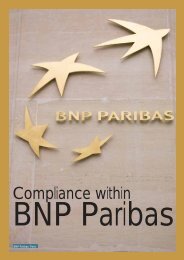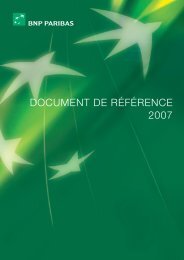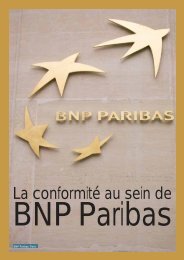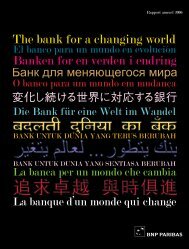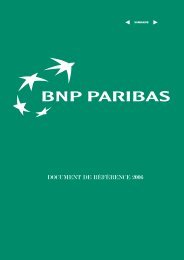2007 REGISTRATION DOCUMENT
2007 REGISTRATION DOCUMENT
2007 REGISTRATION DOCUMENT
- No tags were found...
Create successful ePaper yourself
Turn your PDF publications into a flip-book with our unique Google optimized e-Paper software.
CONSOLIDATED FINANCIAL STATEMENTS5Notes to the financial s tatements p repared in accordance with I nternational Financial Reporting S tandards as adopted by the European Union< Contents >Under IAS 39 as adopted by the European Union (which excludes certainprovisions on portfolio hedging), interest rate risk hedging relationshipsbased on portfolios of assets or liabilities qualify for fair value hedgeaccounting as follows:■ the risk designated as being hedged is the interest rate risk associatedwith the interbank rate component of interest rates on commercialbanking transactions (loans to customers, savings accounts anddemand deposits);■ the instruments designated as being hedged correspond, for eachmaturity band, to a portion of the interest rate gap associated withthe hedged underlyings;■ the hedging instruments used consist exclusively of “plain vanilla”swaps;■ prospective hedge effectiveness is established by the fact that allderivatives must, on inception, have the effect of reducing interest raterisk in the portfolio of hedged underlyings. Retrospectively, a hedge willbe disqualified from hedge accounting once a shortfall arises in theunderlyings specifically associated with that hedge for each maturityband (due to prepayment of loans or withdrawals of deposits).The accounting treatment of derivatives and hedged items depends onthe hedging strategy.In a fair value hedging relationship, the derivative instrument isremeasured at fair value in the balance sheet, with changes in fair valuetaken to profit or loss in “Net gain/loss on financial instruments at fairvalue through profit or loss”, symmetrically with the remeasurementof the hedged item to reflect the hedged risk. In the balance sheet, thefair value remeasurement of the hedged component is recognised inaccordance with the classification of the hedged item in the case ofa hedge of identified assets and liabilities, or under “Remeasurementadjustment on interest rate risk hedged portfolios” in the case of aportfolio hedging relationship.If a hedging relationship ceases or no longer fulfils the effectivenesscriteria, the hedging instrument is transferred to the trading book andaccounted for using the treatment applied to this asset category. Inthe case of identified fixed-income instruments, the remeasurementadjustment recognised in the balance sheet is amortised at the effectiveinterest rate over the remaining life of the instrument. In the case ofinterest rate risk hedged fixed-income portfolios, the adjustment isamortised on a straight-line basis over the remainder of the originalterm of the hedge. If the hedged item no longer appears in the balancesheet, in particular due to prepayments, the adjustment is taken to theprofit and loss account immediately.In a cash flow hedging relationship, the derivative is stated at fair valuein the balance sheet, with changes in fair value taken to shareholders’equity on a separate line, “Unrealised or deferred gains or losses”. Theamounts taken to shareholders’ equity over the life of the hedge aretransferred to the profit and loss account under “Net interest income”as and when the cash flows from the hedged item impact profit or loss.The hedged items continue to be accounted for using the treatmentspecific to the asset category to which they belong.Cash flow hedges contracted to protect the Group against foreign currencyrisk qualified for cash flow hedge accounting up to 31 December 2005,whenever the currency hedged was a currency other than the euro. Inan amendment to IAS 39 effective 1 January 2006, transactions carriedout in the functional currency of the entity initiating the transactionmay no longer be designated as the hedged item in a foreign currencycash flow hedge. Any such hedges existing at that date were thereforedisqualified from hedge accounting.If the hedging relationship ceases or no longer fulfils the effectivenesscriteria, the cumulative amounts recognised in shareholders’ equity asa result of the remeasurement of the hedging instrument remain inequity until the hedged transaction itself impacts profit or loss, or untilit becomes clear that the transaction will not occur, at which point theyare transferred to the profit and loss account.If the hedged item ceases to exist, the cumulative amounts recognisedin shareholders’ equity are immediately taken to the profit and lossaccount.Whatever the hedging strategy used, any ineffective portion of the hedgeis recognised in the profit and loss account under “Net gain/loss onfinancial instruments at fair value through profit or loss”.Hedges of net foreign-currency investments in subsidiaries and branchesare accounted for in the same way as cash flow hedges. The gains andlosses initially recognised in shareholders’ equity are taken to the profitand loss account when the net investment is sold or liquidated in fullor in part. Hedging instruments may be currency hedges or any othernon-derivative financial instrument.Embedded derivativesDerivatives embedded in hybrid financial instruments are extracted fromthe value of the host contract and accounted for separately as a derivativeif the hybrid instrument is not recorded as a financial asset or liabilityat fair value through profit or loss and if the economic characteristicsand risks of the embedded derivative are not closely related to those ofthe host contract.1.c.9Determination of f air v alueFinancial assets and liabilities classified as fair value through profit orloss, and financial assets classified as available-for-sale, are measuredand accounted for at fair value upon initial recognition and at subsequentdates. Fair value is defined as the amount for which an asset could beexchanged, or a liability settled, between knowledgeable, willing partiesin an arm’s length transaction. On initial recognition, the value of afinancial instrument is generally the transaction price (i.e. the value ofthe consideration paid or received).Method of determining fair valueFair value is determined:■ on the basis of quoted prices in an active market; or■ using valuation techniques involving :■ mathematical calculation methods based on accepted financialtheories, and■ parameters derived in some cases from the prices of instrumentstraded in active markets, and in others from statistical estimatesor other quantitative methods.The distinction between the two valuation methods is made accordingto whether or not the instrument is traded in an active market.A market for an instrument is regarded as active, and hence liquid, ifthere is regular trading in that market or instruments are traded thatare very similar to the instrument being valued.1234567891011<strong>2007</strong> Registration document - BNP PARIBAS 121



